Literature
Wilhelm Hildebrand, Die Entwicklung der selbsttätigen Einkammer-Druckluftbremse bei den europäischen Vollbahnen. Berlin 1927.
Jan-Henrik Peters, Personalpolitik und Rationalisierungsbestrebungen der Deutschen Reichsbahn-Gesellschaft zwischen 1924 und 1929. Frankfurt am Main u.a. 1996.
Jan-Henrik Peters, Rationalisierungsbestrebungen der Deutschen Reichsbahn-Gesellschaft zwischen 1924 und 1929, in: Zeitschrift für Unternehmensgeschichte 41, 1996, 187–200.
Manfred Pohl, Sicherheit auf Schiene und Straße. Die Geschichte der Knorr-Bremse AG. (engl. Ausgabe: Safety First by Road and Rail. The History of Knorr-Bremse AG.) München 2005.
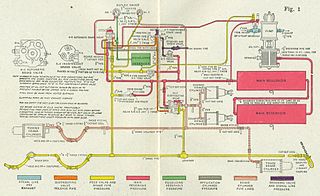
A railway air brake is a railway brake power braking system with compressed air as the operating medium. Modern trains rely upon a fail-safe air brake system that is based upon a design patented by George Westinghouse on April 13, 1869. The Westinghouse Air Brake Company was subsequently organized to manufacture and sell Westinghouse's invention. In various forms, it has been nearly universally adopted.

The Deutsche Reichsbahn, also known as the German National Railway, the German State Railway, German Reich Railway, and the German Imperial Railway, was the German national railway system created after the end of World War I from the regional railways of the individual states of the German Empire. The Deutsche Reichsbahn has been described as "the largest enterprise in the capitalist world in the years between 1920 and 1932"; nevertheless, its importance "arises primarily from the fact that the Reichsbahn was at the center of events in a period of great turmoil in German history".
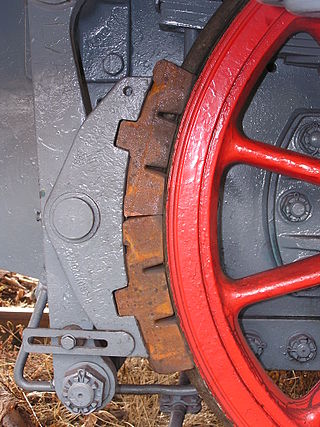
A railway brake is a type of brake used on the cars of railway trains to enable deceleration, control acceleration (downhill) or to keep them immobile when parked. While the basic principle is similar to that on road vehicle usage, operational features are more complex because of the need to control multiple linked carriages and to be effective on vehicles left without a prime mover. Clasp brakes are one type of brakes historically used on trains.

The DRG Class SVT 877Hamburg Flyer – sometimes also Flying Hamburger or in German Fliegender Hamburger – was Germany's first fast diesel train, and is credited with establishing the fastest regular railway connection in the world in its time. Correctly named the Baureihe SVT 877, the diesel-electric powered train was used to carry passengers on the Berlin–Hamburg line. It entered service in 1933.

Knorr-Bremse AG is a German manufacturer of braking systems for rail and commercial vehicles that has operated since 1905. Other products in Group's portfolio include intelligent door systems, control components, air conditioning systems for rail vehicles, torsional vibration dampers, and transmission control systems for commercial vehicles. In 2022, the Group's workforce of over 31,000 achieved worldwide sales of EUR 7.15 billion.

Theodor Georg Knorr was an engineer and entrepreneur on the field of railroad technology and founder of the company Knorr-Bremse. He is particularly remembered for his role in the development of the compressed air brake.

The Neustadt/Weinstrasse Railway Museum is one of the two railway museums run by the German Railway History Company, or DGEG. It is located in the station at Neustadt an der Weinstraße. The other one is the Bochum Dahlhausen Railway Museum.

The German term Verbandsbauart describes both a type of goods wagon as well as a type of tram.
The so-called Austauschbauart wagons were German railway vehicles produced from the late 1920s onwards which had common components built to agreed standards.

German Kleinlokomotiven like the DRG Kö II were developed as locomotives with a low weight and driving power for light shunting duties. There were two classes, based on engine power. The Class II were engines which developed more than 40 HP.
The Saxon Class XVIII was a German six-coupled tender locomotive built for the Royal Saxon State Railways in 1917/18 for express train services. The Deutsche Reichsbahn grouped them in 1925 into DRG Class 18.0.
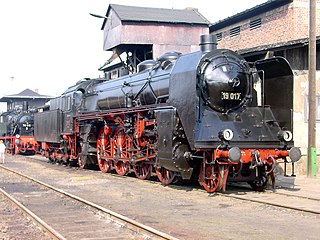
The Saxon Class XX Failed to parse : {\displaystyle \textstyle \mathfrak{H}} were German eight-coupled express train, tender locomotives built for the Royal Saxon State Railways just after the First World War. The locomotives, which became known as the 'Pride of Saxony' (Sachsenstolz) were the first and only German express locomotives with a 2-8-2 wheel arrangement and, at the time of their appearance, were the largest express engines in the whole of Europe. In 1925, the Deutsche Reichsbahn grouped these locomotive into their DRG Class 19.0.

An Ausbesserungswerk is a railway facility in German-speaking countries, the primary function of which is the repair of railway vehicles or their components. It is thus equivalent to a 'repair shop' or 'works'. It is also referred to as a Centralwerkstatt or Zentralwerkstatt or Hauptwerkstatt. During the Deutsche Reichsbahn-Gesellschaft (DRG) period between the two world wars as well as the period of the Deutsche Reichsbahn in East Germany these facilities were called Reichsbahnausbesserungswerke.

The Henschel-Wegmann Train was an advanced passenger express train operated by the Deutsche Reichsbahn in Germany, which ran non-stop express services between Berlin and Dresden from June 1936 to August 1939. Both the DRG Class 61 steam locomotive at its head as well as the coaches were streamlined.
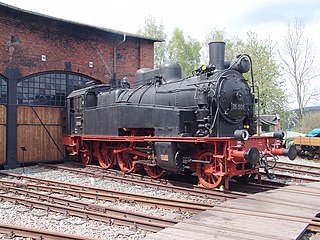
The Saxon Class XIV T locomotives were six-coupled tank engines operated by the Royal Saxon State Railways for mixed duties on main and branch lines. In 1925, the Deutsche Reichsbahn grouped them into their DRG Class 75.5.
The Saxon Class Vs were German, six-coupled, goods train, tender locomotives operated by the Royal Saxon State Railways.
The covered goods wagons of classes Glrhs Dresden and Gltrhs Dresden were first placed in service in Germany by the Deutsche Reichsbahn-Gesellschaft in 1937. The wartime (Kriegsbauart) wagon, the DRB Glmhs Leipzig, and the wartime passenger wagon, the DRB MCi-43, were based on the Dresden classes.

The double-decked MCi railmotor was built in 1882 by Krauss and Company with the works number 1181 and delivered to the Royal Bavarian State Railways, who deployed it in the areas of Würzburg and Bamberg.
Goods wagons of welded construction were developed and built by the Deutsche Reichsbahn in Germany from 1933 to about 1945. With the introduction of welding technology in 1933 almost all wagon components were joined by welding and no longer by rivetting. This enabled goods wagons to be designed, for example, for higher speeds or for higher payloads through the use of different types of steel and other engineering changes, but their further development was so heavily influenced by the exigencies of the Second World War that, as early as 1939, the Deutsche Reichsbahn had to temper the design of goods wagons to the new economic circumstances. Because there were overlaps in the change from the Austauschbauart - goods wagons made with interchangeable components - to the new welded classes, the period of the changeover cannot be exactly defined. Several standard goods wagons and their classes are covered in other articles. Goods wagons built during the Second World War that were purely intended for military transport use, are covered under the article on Kriegsbauart - wartime classes.
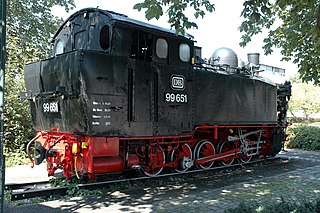
The Saxon VI K were a class of 750-mm gauge 0-10-0T locomotives of the Royal Saxon States Railways with a gauge of 750 mm. In 1925 the Deutsche Reichsbahn (DRG) grouped the locomotives into class 99.64–65; from 1923 to 1927 the procured more locomotives of this type which were grouped in to class 99.67–71.
















